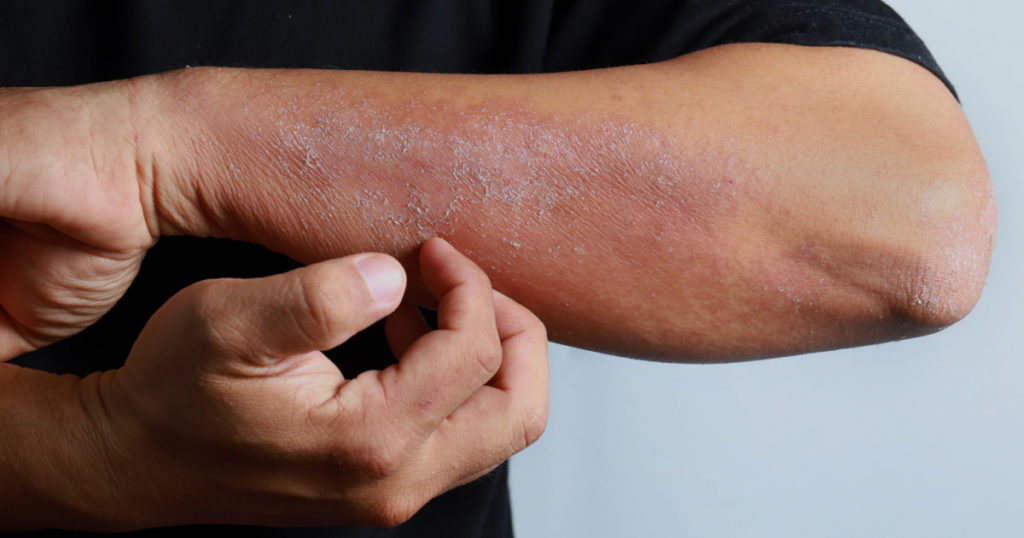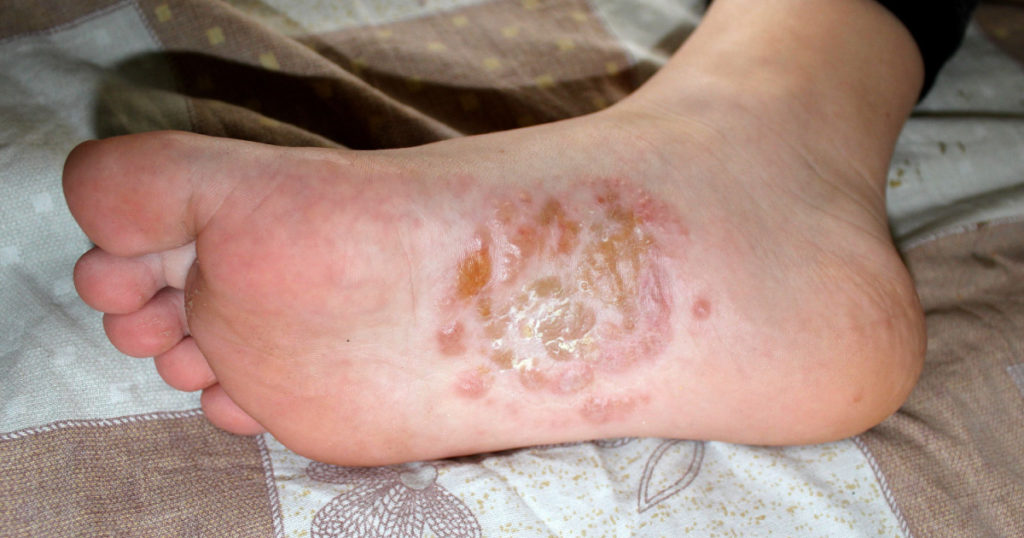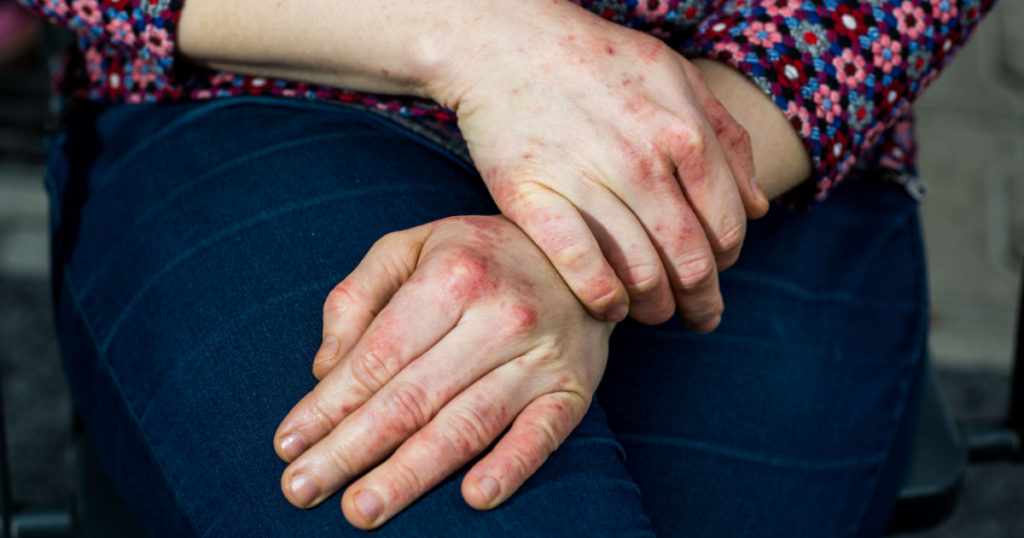With the summer season coming up you’ll no doubt want to spend more time outside, soaking up the sun. But it can be difficult to fully enjoy your time outdoors if you’re constantly worrying about your eczema outbreak. Dyshidrotic eczema, in particular, is prevalent in the spring, and if you’re experiencing small, itchy blisters on your body, you may just have this common form of eczema. While eczema isn’t necessarily curable (yet), it is definitely manageable, and the first step to feeling better is to learn as much as you can about what’s going on with your body and take educated steps to heal it.
What is Eczema?

Eczema is the name given to a group of diseases that cause inflammation of the skin. It is also often called Dermatitis. Eczema on hands and elsewhere in the body is a chronic problem for many people in the United States, with an estimated 35 million Americans experiencing it. Seventy percent of those cases start in children younger than 5 years of age. When an eczema flare-up occurs, the skin will become red, itchy, and swollen with fluid-filled bumps that sometimes ooze and crust. Eczema is often caused by an allergic reaction, and it is not contagious. It can also be hereditary, but it is not curable. Flare-ups are, however, successfully managed with treatment [1]. There are several different types of eczema, and they all affect the body differently, one of the most common being dyshidrotic eczema.
What is Dyshidrotic Eczema?

Dyshidrotic eczema is a common type of eczema that causes small, intensely itchy blisters to form on the edges of the fingers, toes, palms, and soles of the feet. Dyshidrotic eczema is associated with seasonal allergies, and, because of this, the blisters are more likely to erupt in the spring. These blisters can be very painful, and can sometimes take weeks to disappear [2].
If you haven’t heard of this type of eczema before, don’t fret, it does have a few other names that it goes by, including [3]:

- Pedopompholyx (affects the feet)
- Cheiropompholyx (affects the hands)
- Vesicular palmoplantar eczema
- Dyshidrosis
- Foot-and-hand eczema
- Dyshidrotic dermatitis
- Vesicular eczema
- Pompholyx
Symptoms of Dyshidrotic Eczema

Each type of eczema varies slightly in the way that it presents itself, and so the treatment also varies slightly. So, in order to know how to treat yourself, it’s important to recognize your dyshidrotic eczema for what it is. All forms of eczema cause inflammation to the skin, yet they are each different in their own ways. Correctly identifying your dyshidrotic eczema is the first step in relieving your symptoms.
Common dyshidrotic eczema symptoms include [3]:

- Deep-set blisters on hands and feet (specifically on the edges of the fingers, toes, palms, and soles of the feet)
- Itching
- Redness
- Flaking
- Scaly, cracked skin
- Pain
What Causes Dyshidrotic Eczema?

Dyshidrotic eczema is twice as common in women as it is in men, and while it can occur in people of any age, it is most common in adults aged 20-40. People with contact dermatitis, atopic eczema, or hay fever are at a higher risk of developing dyshidrotic eczema. It also is hereditary, so if you have a close relative that has dyshidrotic eczema than your likelihood of getting it increases [3]. Dyshidrotic eczema does have a tendency to get infected, which delays the healing process [3]. If you believe that this is the case for you, then contact your healthcare provider immediately to seek advanced treatment.
How to Treat Dyshidrotic Eczema on Hands

Unfortunately, dyshidrotic eczema is not curable, but in many cases, it is manageable with treatment. While there is no surefire way to prevent flare-ups from happening, a good skincare regime can help to strengthen your skin against inflammation.
Conventional Treatment

While most cases of dyshidrotic eczema may be handled with natural treatments that are less invasive to the body, severe cases are often remedied with dyshidrotic eczema treatment cream (e.g., a corticosteroid cream or ointment or a prescribed injection or pill).
Some other treatments include [4]:

- UV light treatments
- draining large blisters
- antihistamines
- various anti-itch creams
- immune-suppressing ointments, such as Protopic and Elidel
Natural Treatments for Eczema

For health-minded people, these treatments are not the best solution, and a more natural solution is often recommended by healthcare professionals. In general, keeping your skin clean and moisturized is one of the best ways to keep your eczema under control. The kind of treatment that you apply, and how often you apply it will vary depending on your symptoms, but this at-home, natural approach will allow you to feel confident in your choices when it comes to what you’re putting on your skin.
1. Cold Compresses

Soaking the area where the flare-up has occurred, as well as applying cold compresses for 15 minutes at a time will help to reduce the inflammation of the skin. Repeat this process two to four times throughout the day, followed by the application of a moisturizer to the affected area for maximum effectiveness. (The short video above will show you how to apply cold compresses at home to relieve yourself of your eczema pain!)
2. Aloe Vera

The aloe vera plant is known for its ability to soothe irritated skin. Not only that, but it will help to speed up your healing process. To harness the power of aloe, break off a piece of the plant and apply the thick gel to your inflamed skin. Alternatively, you can buy a bottle of natural aloe vera lotion at your local pharmacy.
3. Oatmeal

Oatmeal is often used to relieve skin conditions because of its proven anti-inflammatory properties [5]. Applying oatmeal directly to your irritated skin will help to reduce your eczema symptoms and leave your skin feeling happy and healthy again.
The Bottom Line

When dealing with eczema it’s important to know which kind you have so that you will be better able to treat it. You deserve to enjoy every bit of sunshine this summer, free of pain and embarrassment caused by your eczema flare-up. Learning as much as you can about what’s going on inside of your body will allow you to nip your eczema symptoms in the bud so that you can get back to the sunshine.




